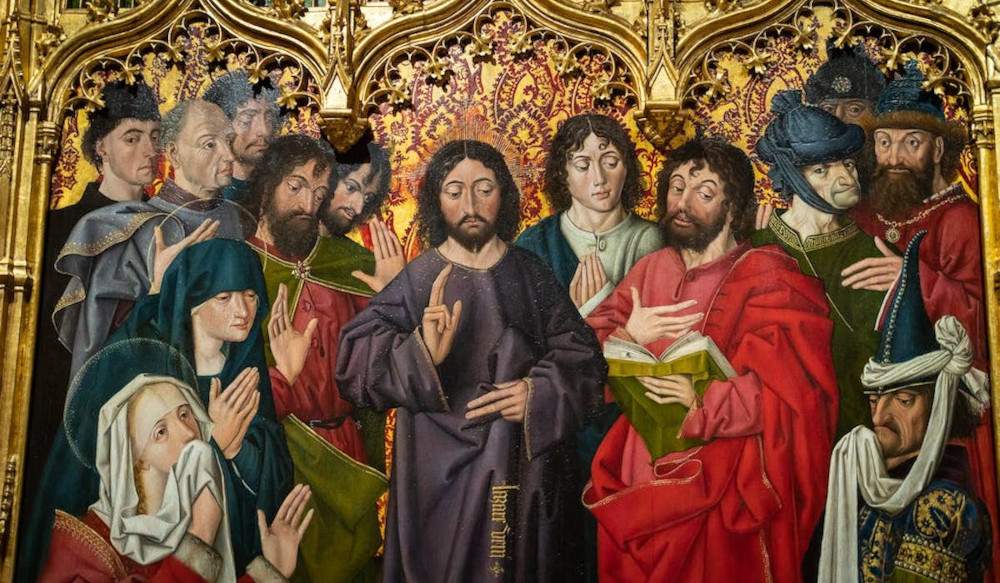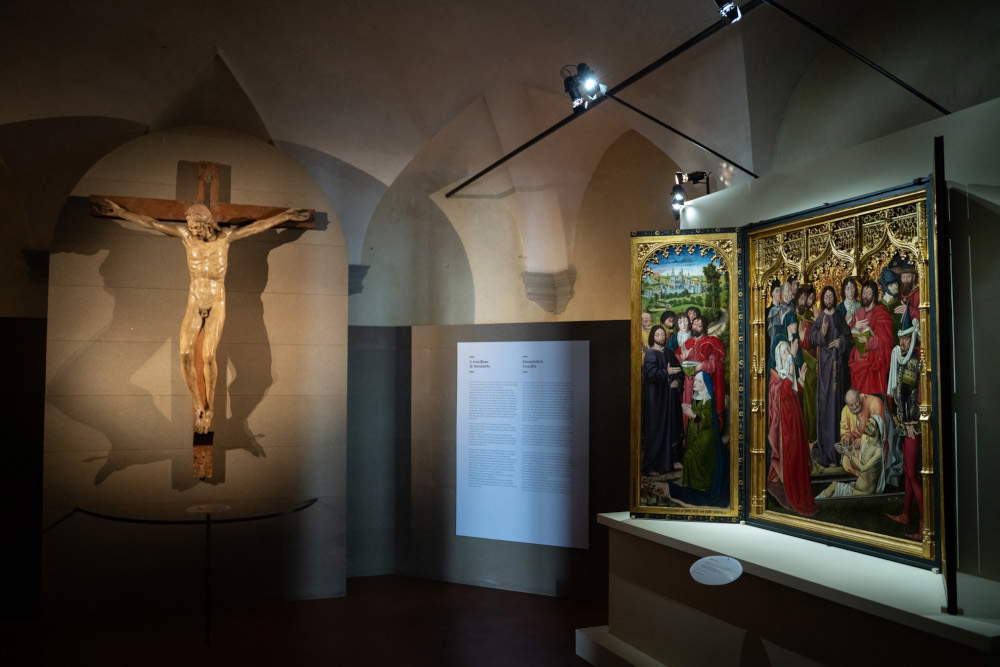On the occasion of an exhibition, a great Renaissance masterpiece returned after nearly two hundred years to the monastery where it had been kept for centuries. It is the Triptych made by the 15th-century French painter Nicolas Froment (Uzés, c. 1430 - Avignon, 1486), which has returned to the convent of San Bonaventura al Bosco ai Frati in San Piero a Sieve (Florence), from where it was removed following the Napoleonic suppressions, eventually reaching the Gallery of Statues and Paintings in 1841. Today, in fact, the masterpiece is part of the Uffizi collections.
Thanks to the exhibition A Renaissance Masterpiece from France to Bosco ai Frati: Nicolas Froment’s Triptych. Terre degli Uffizi in Mugello, supported by theUnione Montana dei Comuni del Mugello and included in the project of Terre degli Uffizi, an exhibition program of Le Gallerie degli Uffizi and Fondazione CR Firenze, within their respective projects Uffizi Diffusi and Piccoli Grandi Musei, it is therefore possible to admire the splendid 15th-century altarpiece in the very place of worship that was its “home” for centuries. The exhibition opened to the public on June 1, 2022, and was supposed to end last November, but the masterpiece is still visible in the Bosco ai Frati convent because, given its great success, it was decided to extend the painting’s stay here until April 30, 2023, in order to give everyone a chance to see it in its former place.
“The exhibition at Bosco ai Frati,” said the Mayor of Scarperia and San Piero, who in the Union of Municipalities has the delegation for Tourism, Federico Ignesti, “has been a great success and the extension is a demonstration of the excellent work born from the synergy and collaboration of all those involved in the organization of this exhibition.” “The positive collaboration between Le Gallerie degli Uffizi, Fondazione Cassa di Risparmio di Firenze and Unione Montana dei Comuni del Mugello has made possible the extension of Froment’s exhibition,” added the Mayor of Vicchio, who in the Union has the delegation for Culture Filippo Carlà Campa, with satisfaction. "This extends the opportunity to visit this masterpiece at the Bosco ai Frati and together our vast cultural heritage, the territory and all its beauties. For our part, we renew our willingness to collaborate and repeat important experiences like this in the museums of the Integrated Museum System."
As already stated, the Triptych by Nicolas Froment, an artist whose activity is documented between northern France and Provence from 1461 to 1483, is considered a true masterpiece of the 15th century. It was commissioned by Bishop Francesco Coppini (Prato, 1402 - Rome, 1464) during his diplomatic missions abroad: the patron, identified by the coat of arms, is depicted praying before the Virgin on the back of one of the wings. The altarpiece is dated 1461 and is signed on the doors.
The masterpiece depicts Stories of Lazarus, Martha and Mary and is divided into three parts. In the center is depicted Jesus resurrecting Lazarus by uttering the words “Lazare veni foras,” written in gold lettering. The resurrected Lazarus, with his body now decaying, rises from the tomb, under the gaze of his sisters Martha and Mary, on whose faces tears flow and one of them wears the white veil over her mouth to wipe them away. On the left flap, on the other hand, is the scene in which Martha goes to meet Jesus to warn him of her brother’s death, while on the right flap Mary pays homage to Jesus by anointing his feet with a perfumed balm, and behind it is a table set; there is also a figure who is drinking.
Influenced by Flemish painting, the artist tends to characterize the physiognomies, which almost take on the appearance of caricatures. The sacred narrative of these episodes from the lives of Lazarus, Martha and Mary is rendered with meticulous depiction of clothing, objects and even curious details such as the fly placed on the set table. Also evocative and painstaking is the rendering of the landscapes in the background, especially in the left-hand flap, which evoke the fairy-tale world of the Northern European courts of the 15th century.
The Triptych arrived at the Bosco ai Frati convent after Bishop Francesco Coppini was recalled to Rome by the pope in the summer of the same year in which the work was made, charged with political offenses and simony. Condemned, he was stripped of his titles and his property was confiscated. The painting thus came into the possession of the Medici family and was then donated to the Franciscan friars of the convent. The Triptych was then placed in the convent’s church, where until the early 19th century there was also the wooden Crucifix of Donatello’s scope, which the public can now see in the same room where the exhibition is set up. The fortune of the convent is also due to Cosimo il Vecchio de’ Medici, who bought the entire area on which the religious complex and the adjacent forest still stands today, taking over its patronage and the direction of the modernization work, which he entrusted to the architect Michelozzo.
The Triptych was the subject of a restoration some years ago generously funded by the Friends of the Uffizi, but it had returned to storage after an exhibition at the Uffizi documenting its recovery, due to ongoing work at the museum and pending the giving of the masterpiece a new display. The exhibition at Bosco ai Frati is therefore an opportunity for many to admire the restored work for the first time. “The fact that the Medici-certainly Cosimo Pater Patriae-had promptly hoarded it after the commissioner’s fall from grace is further proof of the taste for Nordic painting that was very early in Florence,” Uffizi Galleries director Eike Schmidt had explained at the opening of the exhibition.
“Bringing back Froment’s Triptych and exhibiting it in the Sala del Capitolo, together with the Christ of Donatello’s ambit, was a dream for us,” concluded Gianni Frilli, OFM Tuscany contact person for the Bosco ai Frati Museum. “The availability of the Uffizi Galleries, the generosity of the Fondazione Cassa di Risparmio di Firenze, the contribution and coordination of the Unione Montana dei Comuni del Mugello, and the collaboration with the ProLoco of San Piero a Sieve, well, they made it possible. A great team effort, for an event that strengthens the identity of our territory.”
The exhibition is supported by the Unione Montana dei Comuni del Mugello in collaboration with the Municipality of Scarperia/San Piero a Sieve and the Convent of Bosco ai Frati itself, and can be visited with free admission until April 30, 2023 from Friday to Sunday and holidays from 9:30 a.m. to 12:30 p.m. and 3 to 6 p.m.




 |
| Froment's Renaissance Triptych in the convent that was his home. Still for two months |
Warning: the translation into English of the original Italian article was created using automatic tools. We undertake to review all articles, but we do not guarantee the total absence of inaccuracies in the translation due to the program. You can find the original by clicking on the ITA button. If you find any mistake,please contact us.